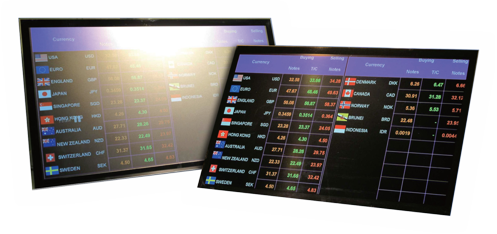
KYOCERA Enhances LCD Performance with New Optical Bonding Technology
The Advantages of Optical Bonding
Kyocera's In-house Optical Bonding Solution
Michigan facility becomes “one-stop shop” for LCDs requiring touch-panels and protective glass
Kyocera International, Inc., a world-leading electronic device manufacturer, has expanded its U.S. production capabilities to provide full-service integration of LCD displays, touch-panels and protective glass using its new, state-of-the-art optical bonding technology, which dramatically enhances the LCD viewing experience. Optical bonding reduces reflection by 70 percent while improving color saturation, clarity and improving screens’ ruggedness.
Conventional LCD Bonding
LCD applications increasingly require a touch-panel interface and/or protective glass to guard against surface scratches and impact. Integrating these components has traditionally involved a process known as “perimeter bonding,” which creates an air gap between the surface of the LCD and the touch-panel or protective glass. This method is widely adopted because air introduces less optical distortion than liquid adhesive. However, the air gap limits optical performance.
Optical Challenges Resulting from Air Gaps
Air within an optical component interface creates internal reflectance (glare) that causes images to “wash out” and impedes visibility. Over time, the display can also become foggy and dirty as moisture and foreign particles get trapped inside. Finally, air gaps introduce optical distortion known as parallax, which creates variation in the apparent position of an object viewed along two lines of sight. For these reasons, alternative LCD bonding technologies are in great demand.
Kyocera’s Optical Bonding Technology
Conventional adhesives that could eliminate the air gap within an LCD module generally introduce other optical challenges. However, Kyocera has developed a UV-cured adhesive that can eliminate the air gap while offering optical transparency comparable to that of air. Kyocera’s optical bonding technology reduces internal reflection by up to 70 percent by eliminating the air gap, dramatically enhancing front-of-screen performance in contrast, clarity and color saturation, while resolving issues relating to condensation, foreign particles and parallax. Additionally, by laminating the display and cover layer into a single integrated module, Kyocera’s optical bonding enhances ruggedness and shock resistance for applications in automotive, aviation, medical, mobile, ATM, kiosk and defense-related equipment.
“Kyocera is pleased to offer optical bonding technology at our Class 1000 cleanroom facility in Plymouth, Michigan,” said Cynthia Ferrell, Senior Division Vice President of Kyocera International, Inc.’s Display Division. “This new capability allows us to provide a one-stop total solution backed by our full manufacturer’s warranty.”

Perimeter Bonding vs Optical Bonding
For the image on the right, floated aluminosilicate glass Xensation® Cover made by SCHOTT was used. This glass type is especially suitable for displays thanks to its high strength. The gap between display and glass cover was filled with a special DELO adhesive. This bonding increases the durability of the composite and its resistance to oscillations and shocks. Photos courtesy DELO Industrial Adhesives.